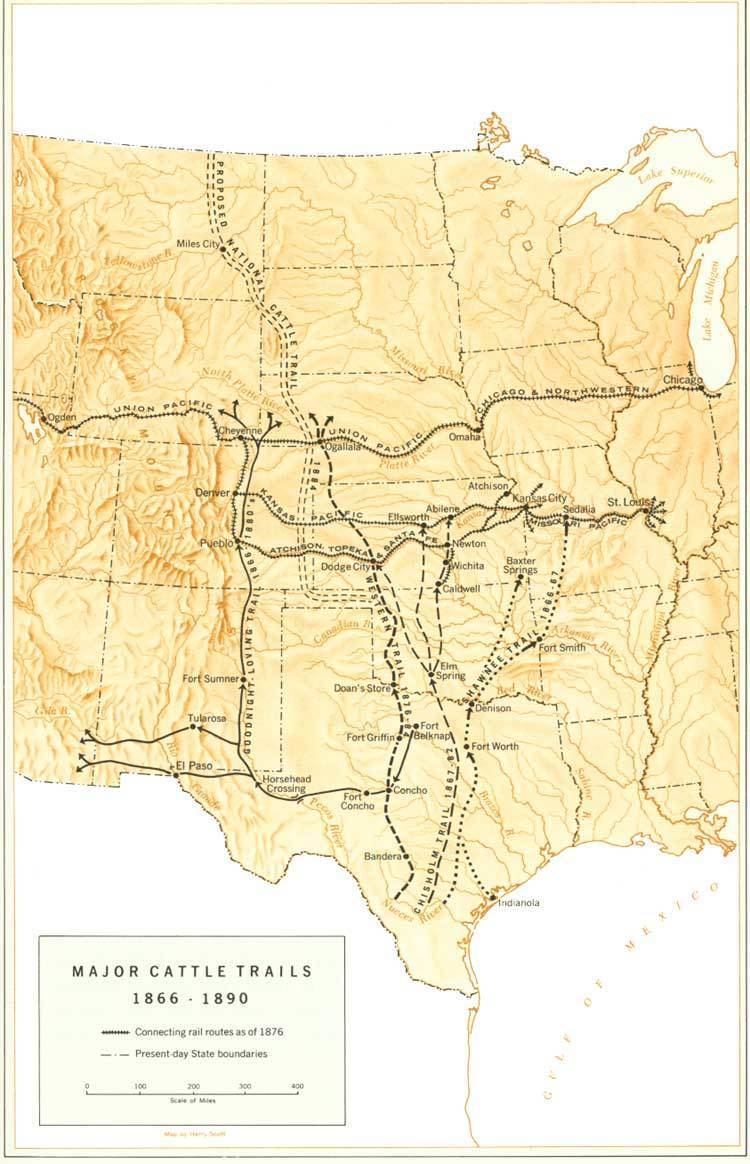Address Capulin, NM 88414, USA | Phone +1 214-783-7266 | |
 | ||
Similar Capulin Volcano National, Folsom Archaeol Site, Sugarite Canyon State Park | ||
The Goodnight–Loving Trail was a trail used in the cattle drives of the late 1860s for the large-scale movement of Texas Longhorns. It is named after cattlemen Charles Goodnight and Oliver Loving.
Contents
Route
The Goodnight Loving Trail began at Fort Belknap (Texas), along part of the former route of the Butterfield Overland Mail, traveling through central Texas across the Staked Plains to Horsehead Crossing, north along the Pecos River and across Pope's Crossing, into New Mexico to Fort Sumner. The trail then continued north into Colorado up to Denver and was extended on into Wyoming.
Goodnight and Loving's Drive of 1866
In June 1866, Charles Goodnight and Oliver Loving decided to make a partnership to drive cattle to growing western markets. They hoped that demand for beef from settlers, from soldiers stationed at military outposts across New Mexico, and from Navajos recently placed upon reservations near Fort Sumner, would make the drive profitable. With eighteen cowpunchers, they brought 2,000 head of cattle to Fort Sumner, New Mexico. Over eight thousand Navajo had been interned at the Bosque Redondo reservation under the control of the fort, but due to the poor conditions on the reservation for agriculture and inadequate planning by the US authorities for provisions, there was an urgent demand for new food supplies. Goodnight and Loving received eight cents a pound for the steers in the herd, although they were unable to interest the government agent in 800 stocker cattle. Goodnight returned to Texas with approximately $12,000 in gold to buy more cattle.
Loving continued north towards the railhead in Denver, Colorado with the remaining cows and calfs. He was stopped by a tollgate chain in the Raton Pass, operated by Richens Lacey Wootton. Loving paid Wootton 10 cents per head of cattle. In Denver, Loving sold the herd to John Wesley Iliff.
Later developments
During the Drive of 1867, at Horsehead Crossing, during a heavy storm, the herd was attacked by a party of Comanches, leaving it divided and scattered. Loving and "One Arm Bill" Wilson rode ahead towards Fort Sumner to advise them of the delay. They were ambushed by Comanches, and while both managed to escape, Loving died later refusing to have an amputation. Goodnight drove herds along the route over Raton Pass again in 1868, paying the toll. In February 1868, he began to drive slaughter herds to Cheyenne, Wyoming to be butchered and both marketed locally and shipped by railroad to markets in Chicago.
In 1868 he also scouted a new route via the Trincheras Pass, in order to sell cattle to John W Iliff in Cheyenne. Iliff had become established as a leading commercial cattle rancher in his holdings along the Platte river, and sold beef to mining camps, railroad workers and government agents working on Indian reservations. Over the next decade, cattle ranches stocked with Texas Longhorn brought up along were established across Wyoming. Several Texas companies relocated or started subsidiaries in Wyoming and Montana. Cheyenne became a hub for the local cattle business, with its Union Pacific railroad connection.
